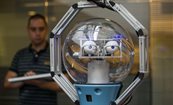
As part of one of the panels run by NESTA during the creation of the Longitude Prize, and, more recently, as a contributor to the BBC Horizon documentary on the prize, I have been asked a lot about how robots, particularly ‘autonomous robots’, will change our lives in the future.
Autonomous robots are those which are able to make decisions for themselves, as opposed to more traditional industrial robots which have to have their every move pre-programmed by a human expert. The decisions made by autonomous robots are currently quite simple - mostly related to how to move, or where to move to - but these will increase in complexity as our understanding of the use of artificial intelligence (AI) on robots in the real world increases.
Predicting the future, particularly where science and technology is involved, is a difficult task, but some clear trends emerged during the Longitude discussions. Under the ‘Paralysis’ topic, the use of exoskeletons to provide mobility and strength was a prominent idea. Exoskeletons are simply robots you wear. They may not look like a traditional robot, but they have all the necessary parts (sensors, actuators and the ability to be programmed to automate a task) to be considered one. Future exoskeletons will also be more autonomous, able to anticipate situations and prepare responses in advance.
Under the ‘Dementia’ Longitude Prize topic, we discussed the use of autonomous robots to support people with dementia living in their homes for longer. This is just one aspect of the more general theme of using robots for assisting ageing people to live independently for longer, improving their quality of life, and reducing their impact on health services. Such robots may do anything from providing reminders and connecting residents to remote loved ones and carers, to monitoring how, where and when people move around their house (looking out for falls or abnormal behaviour). A much longer-term aim is for robots to provide physical assistance, either with movement (standing up, walking) or with household tasks such as cooking and cleaning. Sadly the science and engineering, both in AI and the ability to build and control suitable robot bodies for such a range of tasks, is still many tens of years away at least.
Away from the Longitude Prize areas, we will see autonomous robots - and related technology - appear in many aspects of our lives. This may be in forms that we easily understand as robots today (e.g. machines that clean floors, carry pallets in warehouses or monitor oil pipelines) or as elements within other systems (e.g. driver assistance aids, surgical support tools, or prostheses). The most important thing to understand is that robot technology won't appear as fully formed humanoid robots with human-like intelligence capable of doing anything. This, particularly the intelligence part, is a science fiction dream we're not even close to being able to describe as a well-formed problem, let alone create solutions for. Instead, robot technology will emerge through special-purpose tools which will allow us to increase the quality of our lives in many aspects, whether it's caring for our loved ones, or making our businesses more productive.
Dr Nick Hawes is Senior Lecturer in Intelligent Robotics in the School of Computer Science. (You can also follow him on Twitter - @hawesie.)